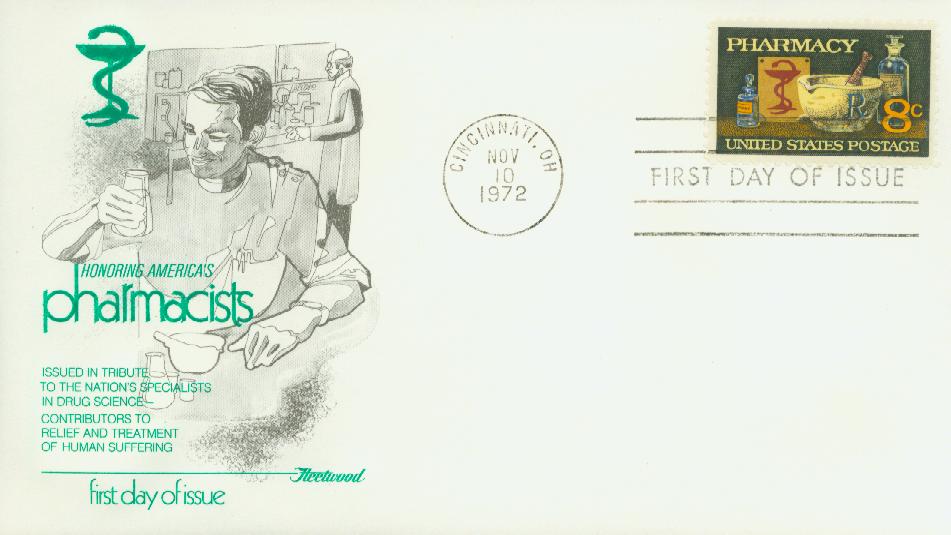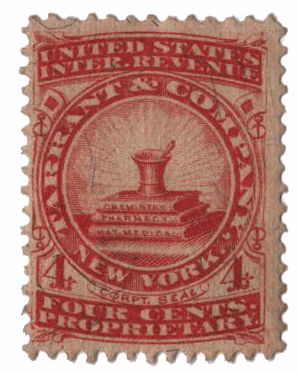
# 1473 FDC - 1972 8c Pharmacy
American Pharmaceutical Association

On October 6, 1852, the American Pharmaceutical Association (APhA) was founded in Philadelphia, Pennsylvania.
In the mid-1850s, there were no laws regulating the pharmacy practice. Patients were often given treatment based on their symptoms, instead of diagnosing a specific disease. And anyone with enough money could open their own apothecary.

So in the fall of 1852, a group of 20 men met in Philadelphia to discuss these issues as well as one of their greatest concerns, drug quality. Among those present was William Procter, Jr., who later came to be known as the Father of American Pharmacy. Of the meeting, he said, “Fewness of members should not deter pharmacists from associating. A dozen well-disposed men can accomplish wonders when enlisted in a common cause and animated by a single interest.”

During that initial meeting, the attendees discussed the accomplishments of the pharmacy profession over the past 150 years and looked at the history of pharmacy governance. They also discussed the creation of a headquarters, the future of pharmacotherapy, and the history of pharmacoeconomics.

That same year, a Kentucky court weighed in on the role of pharmacists, stating “Purchasers have to trust their druggists. It is upon his skill and prudence that they most rely. It is his duty to know the properties of his drugs and be able to distinguish them from each other. It is his duty to qualify himself so that, when a prescription is presented to be made up, the proper medicines, and none other, be used in mixing and compounding.” This was a major change, as previously consumers were given little protection under the law for the medicines they may receive. This law helped mark a distinction between pharmacies and ordinary merchants.

The APhA, the first professional society of pharmacy in the US, would evolve in the coming years. It helped regulate the practice of dispensing medicine and encouraged pharmacists to develop close relationships with the doctors who prescribed the medicine. By the early 20thcentury, a series of laws were passed that helped to regulate the pharmaceutical field. In 1906, there was the Pure Food and Drug Act, protecting people from misbranded medications. And in 1938, there was the Food, Drug, and Cosmetic Act, which called on the FDA to require that new drugs be deemed safe before being marketed.
Today, the American Pharmacists Association, as it was renamed, has its headquarters on the National Mall in Washington, DC, and includes a membership of more than 62,000 practicing pharmacists and other pharmaceutical professionals. The APhA meets every year to discuss policies for their profession. And most other pharmacy organizations were created out of the APhA.
In 1972, the USPS issued a stamp to honor the 120th anniversary of the American Pharmacists Association. The stamp pictures a mortar and pestle, Bowl of Hygieia, and 19th-century medicine bottles. Hygieia was the Greek goddess of health. Hygieia holding a patera (medicine bowl) with a snake coiling around her and about to eat from the bowl has come to symbolize pharmacy. The snake represents the patient and its choice of whether or not to take the medicine to help itself. The American Pharmacists Association has adopted the Bowl of Hygieia as its symbol.
American Pharmaceutical Association

On October 6, 1852, the American Pharmaceutical Association (APhA) was founded in Philadelphia, Pennsylvania.
In the mid-1850s, there were no laws regulating the pharmacy practice. Patients were often given treatment based on their symptoms, instead of diagnosing a specific disease. And anyone with enough money could open their own apothecary.

So in the fall of 1852, a group of 20 men met in Philadelphia to discuss these issues as well as one of their greatest concerns, drug quality. Among those present was William Procter, Jr., who later came to be known as the Father of American Pharmacy. Of the meeting, he said, “Fewness of members should not deter pharmacists from associating. A dozen well-disposed men can accomplish wonders when enlisted in a common cause and animated by a single interest.”

During that initial meeting, the attendees discussed the accomplishments of the pharmacy profession over the past 150 years and looked at the history of pharmacy governance. They also discussed the creation of a headquarters, the future of pharmacotherapy, and the history of pharmacoeconomics.

That same year, a Kentucky court weighed in on the role of pharmacists, stating “Purchasers have to trust their druggists. It is upon his skill and prudence that they most rely. It is his duty to know the properties of his drugs and be able to distinguish them from each other. It is his duty to qualify himself so that, when a prescription is presented to be made up, the proper medicines, and none other, be used in mixing and compounding.” This was a major change, as previously consumers were given little protection under the law for the medicines they may receive. This law helped mark a distinction between pharmacies and ordinary merchants.

The APhA, the first professional society of pharmacy in the US, would evolve in the coming years. It helped regulate the practice of dispensing medicine and encouraged pharmacists to develop close relationships with the doctors who prescribed the medicine. By the early 20thcentury, a series of laws were passed that helped to regulate the pharmaceutical field. In 1906, there was the Pure Food and Drug Act, protecting people from misbranded medications. And in 1938, there was the Food, Drug, and Cosmetic Act, which called on the FDA to require that new drugs be deemed safe before being marketed.
Today, the American Pharmacists Association, as it was renamed, has its headquarters on the National Mall in Washington, DC, and includes a membership of more than 62,000 practicing pharmacists and other pharmaceutical professionals. The APhA meets every year to discuss policies for their profession. And most other pharmacy organizations were created out of the APhA.
In 1972, the USPS issued a stamp to honor the 120th anniversary of the American Pharmacists Association. The stamp pictures a mortar and pestle, Bowl of Hygieia, and 19th-century medicine bottles. Hygieia was the Greek goddess of health. Hygieia holding a patera (medicine bowl) with a snake coiling around her and about to eat from the bowl has come to symbolize pharmacy. The snake represents the patient and its choice of whether or not to take the medicine to help itself. The American Pharmacists Association has adopted the Bowl of Hygieia as its symbol.






